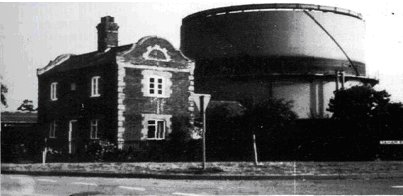
The Gas WorksAn important commodity in the form of gas was brought to the town in 1859. During the year large gas storage containers were erected on a site opposite the West End Stores and a house to accommodate the works manager was built adjoining it, in Cley Lane. Underground pipes were laid along the main roads of the town and the once familiar iron gas lamp standards were erected every hun dred yards or so. These had to be lit individually by the "gas man" walking, or cycling, around the town carrying a long pole with a hook on the end that enabled him to pull down a ring on the end of a chain, thus allowing a free flow of gas to set the small pilot jet in operation. This operation was carried out at varying times during the winter, according to the hours of daylight, but at 10p.m. every night his familiar figure could be seen again as he made his second journey of the evening around the deserted streets to extinguise the lights one by one. Several of the larger houses were also connected to the gas mains and thus for the first time in Watton's history, the more affluent residents were able to install a gas cooker. There were a number of by-products from the gas works, notably coke and tar, which found a ready market. The former was coal half burnt and so deprived of its gases. It was then used as fuel by some of the business firms for heating boilers and the bakers also made use of it for heating their large ovens. The tar was also in great demand, being used for waterproofing the clay lump cottages and for use as a binding medium and waterproofing the upper layer of shingle used in the construction of our earlier roads.
Public ServicesAbout the same time as the gas mains were laid along the main streets of the town in 1859 the first sewerage works were also constructed along Norwich Road, the High Street and Harvey Street. This was a large brick-built system that discharged the effluent into a sewer bed situated about 150 yards behind the gas works. Although well over a hundred years old this brick system is still serving the town, but no longer in its original purpose, as it now acts as a surface water drain. In the spring of 1951 contractors commenced work on the first stage of the new sewerage system for Watton and for the next few years there was much inconvenience to traffic as the various roads were ripped up and the main pipes laid along all the roads and finally to the new sewerage works that were constructed at Threxton. With the completion of the first stage, no time was lost in getting the second stage on the way, this involved the connection from the individual properties to the mains and by 1957 this stage had reached the town centre, so it was nearing 1960 before all the properties were connected. |

